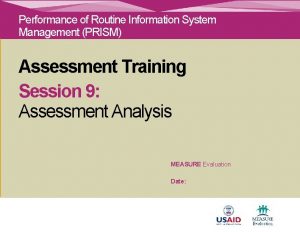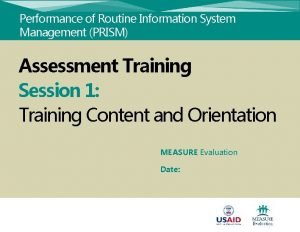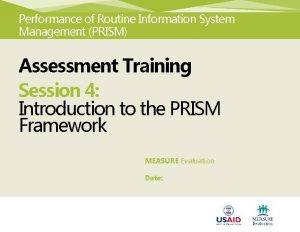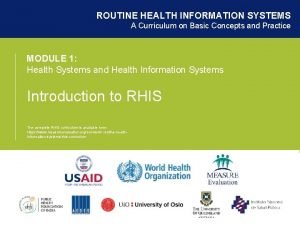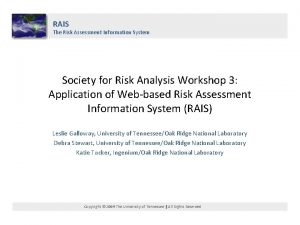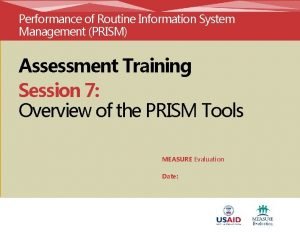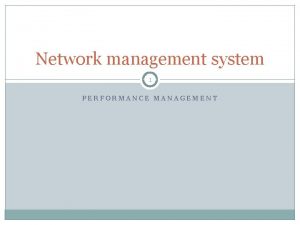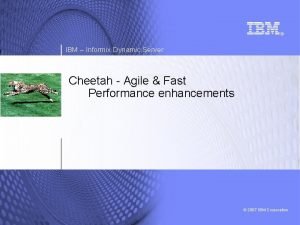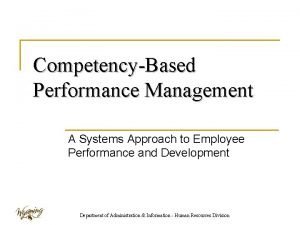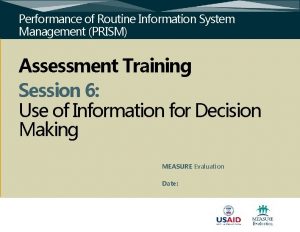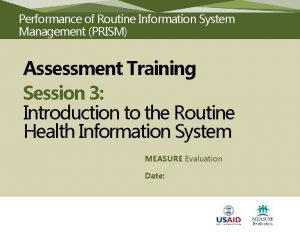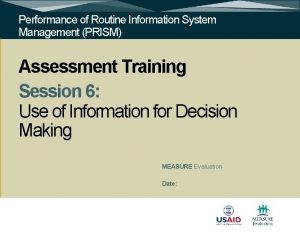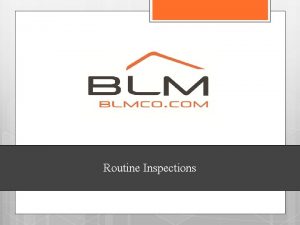Performance of Routine Information System Management PRISM Assessment












- Slides: 12

Performance of Routine Information System Management (PRISM) Assessment Training Session 2: Introduction to the Health Information System MEASURE Evaluation Date:

Session objectives • Define the health system and its generic functions • Describe the relationship between the health system and the health information system (HIS) • Describe the relationship between the health system and the routine HIS (RHIS) 2

What is a health system and what are its components? It is all the organizations, institutions, resources, and activities whose primary purpose is to promote, restore, or maintain health. It needs staff, funds, information, supplies, transport, communications, and overall guidance and direction. It needs to provide services that are responsive and financially fair.

Functions and goals of a health system Functions Goals/outcomes (6 building blocks) Service delivery I Human resources N P Information U T Commodities infrastructure S Financing Leadership and governance Source: World Health Organization (WHO), 2000 Access Improved health Quality Coverage Responsiveness Social and financial risk protection Safety Improved efficiency

What is an HIS? An HIS is a system that provides specific information support to the decision-making process at each level of the health system

Health information system Responsive & efficient health system Good decisions Use Good data Data quality assurance Data management Well-functioning information systems

Health information Nonroutine data system Routine data Administrative records systems Census Vital registration Populationbased surveys Population-based data sources Services records systems Individual records systems Health institution (including community-based data sources)

How does the HIS help to address health challenges? At the patient/client (health service delivery) level • Management of an individual patient/client using information on health status, health services, behavior and practices, and risks • Management of the health of the family and household • Management of vaccines, drugs, and the cold chain At the health unit level • Management of resources for efficient and equitable allocation, distribution, and use • Planning program interventions; annual planning • Monitoring and evaluation (M&E) of heath services coverage and performance • Disease surveillance At the health system level • • Health systems research Policy and strategy decisions Formulating specific programs Resource management • • Capacity building Disease surveillance Innovations Research, monitoring, and evaluation

Core components of a wellfunctioning HIS Governance Policies, plans, and accountability Data standards and data architecture Human resources Data collection and management Individual client data Aggregated facility data Facility data on causes of death Health facility assessment Community-based services data Data quality, analysis, dissemination, & use Data quality assessment Monitoring quality of care Analytical methods Data sharing

Brainstorm What are enablers and barriers of: 1. Assuring data quality? 2. Using HIS information?

How to access the PRISM Series This slide deck is one of nine in the PRISM Series Training Kit, which also includes a Participant’s Manual and a Facilitator’s Manual. Also in the PRISM Series is a Toolkit (the centerpiece of the series) and a User’s Kit. The PRISM Series is available in its entirety on MEASURE Evaluation’s website, here: https: //www. measureevaluation. org/prism

MEASURE Evaluation is funded by the United States Agency for International Development (USAID) under the terms of Cooperative Agreement AID-OAA-L-14 -00004. It is implemented by the Carolina Population Center, University of North Carolina at Chapel Hill, in partnership with ICF International; John Snow, Inc. ; Management Sciences for Health; Palladium; and Tulane University. The views expressed in this presentation do not necessarily reflect the views of USAID or the United States government. www. measureevaluation. org
 Performance of routine information system management
Performance of routine information system management Performance of routine information system management
Performance of routine information system management Prism framework
Prism framework District level routine information system
District level routine information system Chapter 11 performance appraisal - (pdf)
Chapter 11 performance appraisal - (pdf) Performance appraisal process
Performance appraisal process Risk assessment information system
Risk assessment information system Prism assessment tool
Prism assessment tool Network performance management definition
Network performance management definition Ibm checkpoint performance management system
Ibm checkpoint performance management system Dimensions of performance management
Dimensions of performance management Competency based performance management system
Competency based performance management system Performance management and reward system
Performance management and reward system
